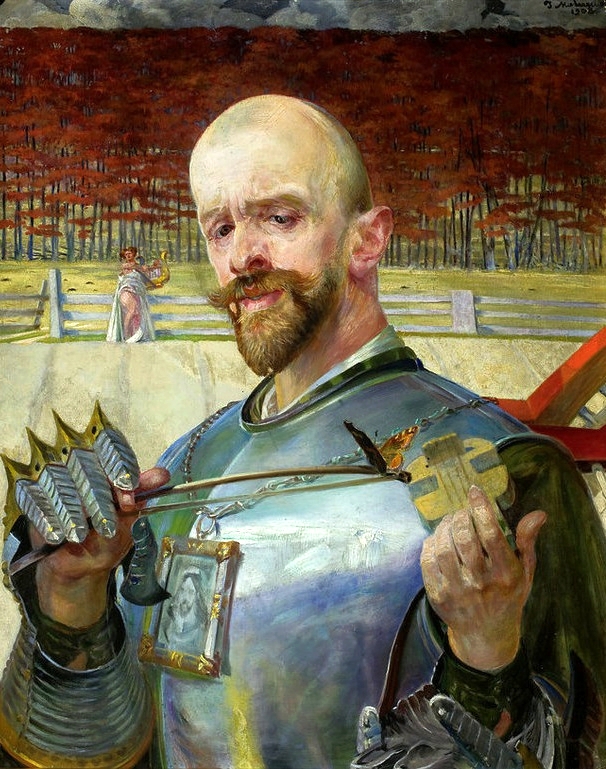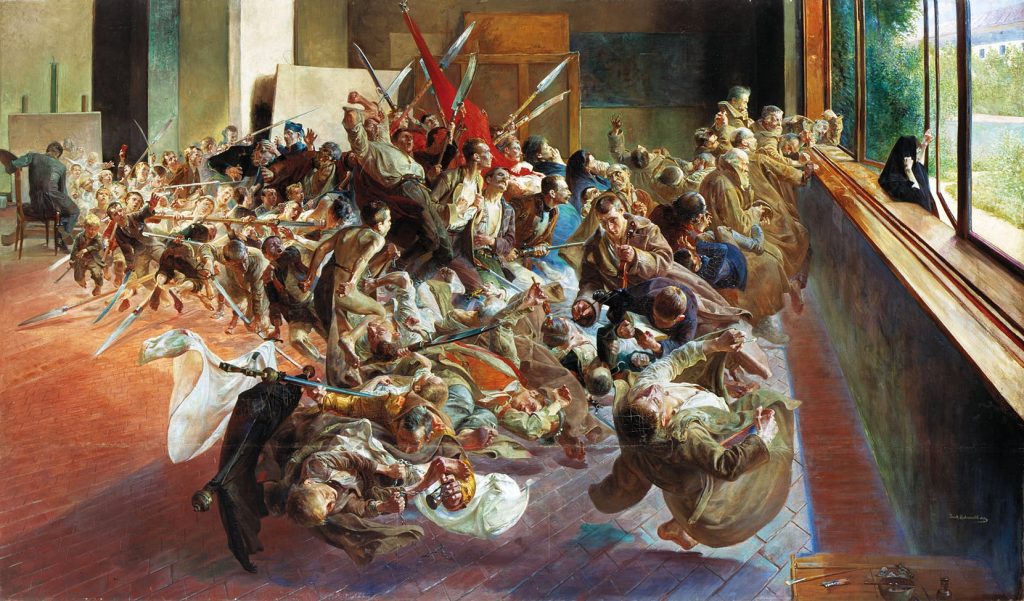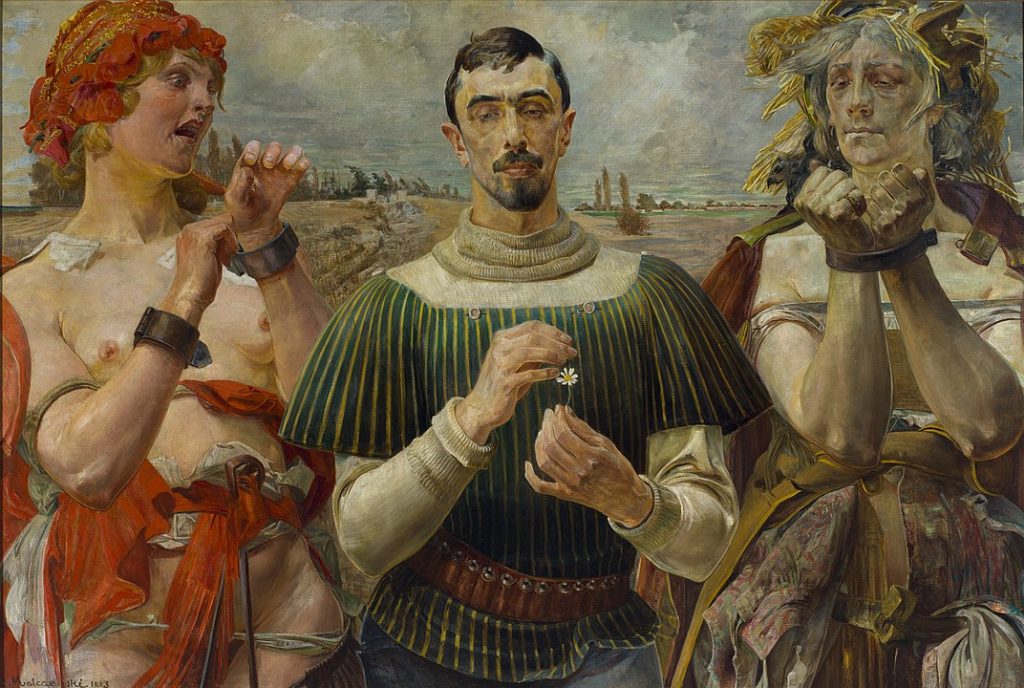45 Chapter 12 – Jacek Malczewski: History Depicted Through Art
Symbolism
Emilie Ashton
Audio recording of chapter is available here:

Jacek Malczewski, one of the most revered painters of Poland, was a symbolic painter of the late 19th and early 20th century. In his paintings, Malczewski dealt with universal themes of human life and death, an act of artistic performance, and the entanglement of men in history and politics through intellectual motifs and pictorial metaphors.[1] Malczewski’s heavy themes make sense given that he belonged to a generation which had grown up in the discouragement and depression that had followed the failure of Poland’s uprising in 1863, which initially aimed to restore the Polish-Lithuaniam Commonwealth .[2] This tragic event became his most persistent themes in his artworks. Throughout his years as a painter, Malczewski depicted the state of his home country through symbolic pictures which evolved over time. In his early works, Malczewski focused on the consequences of the Uprising, such as exile, through the use of characters related to Polish literature.[3] This is apparent in The Painter’s Dream. About a decade later, Malczewski continued the topic of Poland’s lack of freedom in Melancholy, which portrayed the mental state of the nation after the loss of independence.[4] Later on in his life, the artist depicts a specific episode from the time of the Uprising through a triptych in My Life.[5] Malczewski’s pessimism and weariness of the nation’s state was expressed in personal dreams and visions through colour, form, and composition. Through the use of symbolism, Malezewski artistically depicted his life and the historically tragic condition Poland was in.
Many of Malczewski’s early works contain a concerning amount of death and illusions compared to his later works. In The Painter’s Dream, the land is occupied by figures painted in noticeably different styles with knocked-over supplies and an abandoned parasol. The figures are also faceless and give off the illusion that they are floating. An article by Elizabeth Clegg gives reasons as to why his early pieces are like this and the inspiration behind them.[6] She states that the faux terrain of the paintings gives an illusion to some of the painting’s contents. The article explains that the faux illusion in Malczewski’s paintings serves as a term for the anxieties felt by Poles about their political and spiritual situation as the 19th century came to an end.[7] The faux terrain continued in the artist’s thoughts and feelings, just as it continued to provide a suitable description of his most enduring subject, Poland. In The Painter’s Dream and many other portraits done by Malczewski during this time, the expression of regret or uncertainty is conveyed by figures against, rather than in, a landscape setting.[8]

Created in 1894, Melancholy (or Melancholia) is considered to be Jacek Malczewski’s “manifesto.”[9] Though the painting is abundant in symbols, gestures, and stories that are open to multiple interpretations, it can be agreed that Melancholy portrays the mental state of the Polish nation after the loss of independence.[10] Malczewski followed tradition and created a historiosophical vision but replaced the reconstruction of historical reality with a dreamish space positioned on the verge of reality.[11] Malczewski painted a dream into which the nation sank. This is seen not only through the dreamlike atmosphere and ghosts in the overcrowded room, but also by the black figure of Melancholy itself, who is seen sitting on the window ledge.[12] The small figure dressed in black and placed to the side of the painting is hard to see at first glance, though it is the main symbol of the painting. This slouched figure represents the curse that hung over the Poles and reflected the nation’s spirit.[13] The meaning of this symbolic character is quite somber considering the fact that the figure is placed on an open window ledge looking down.
One common interpretation of the painting follows the angered feeling of loss dominating the thoughts and actions of many Polish citizens, which transformed into a chronic state, a danger for the nation, and a threat for the nation’s identity.[14] This is seen through the chaotic mesh of figures in the center of the painting. The atmosphere of apathy and helplessness is juxtaposed with a sense of empowerment and creative forces.[15] Meaning that, although the figures’ facial expressions show failure and disinterest, their body language shows a direct call for action. The cluster of characters from the imaginative world shows a parade of Poles wanting to fight for their freedom.[16] Malczewski used symbolism through the dark figure and the empowered characters to show that, although the nation felt hopelessness, ambition should not be lost.

Later on in his life, Jacek Malczewski began using triptychs in order to portray three paintings with three different perspectives. The cognitive-emotional content presented in these triptychs gave the viewer an illusion of taking part in the event.[17] Through this, Malczewski presented both the tragic episodes and the heroes of the Polish national uprising in the manner of post-Romanticism. In particular, the painting My Life, depicted a specific episode from the unsuccessful uprising of 1864. Though, just focusing on the center part of the triptych, the moral and political ambiguous atmosphere is clear. There is much to say about the center part of this triptych. Malczewski shows a typical Polish manor house, with an old, sad servant wiping glasses for an uninvited group of Russian officers.[18] However, the viewer can only see the Russian officers’ coats and swords. The soldiers, who are main characters of this painting anecdote, are presented indirectly through their accessories and the downcast eyes of the old man signifies the depressive mood of the painting. Ordinary and contrasting objects, such as the coats and swords, as well as the absence of leading characters, is the origin domain transferring their features onto the target domain, which is the emotional, moral, and politically ambiguous atmosphere.[19] Through this anecdote, Malczewski depicted a specific episode from the unsuccessful uprising of 1864 by applying narrative structure. This is shown through the use of deliberate, symbolic, and significant arrangements of objects and literary backgrounds.
While other artists steeped themselves in purely visual Impressionism, Jacek Malczewski yearned to express himself as a human being, deeply sensitive to the fortunes and misfortunes of man and mankind.[20] He observed the noisy turmoil of life while his highly sensitive nature absorbed more of its sorrows and suffering than of its joy. Malczewski dealt with universal themes of human life and death, an act of artistic performance, and the entanglement of men in history and politics through intellectual motifs and pictorial metaphors.[21] The artist attained a specific type of magic in his paintings. His paintings were situated in a dreamed reality, in surrealistic worlds, because they were more significant than what they were in reality.[22] Malczewski’s paintings aimed to represent Polish sorrows and yearnings through this dreamed reality. Through the use of symbolism, Malczewski artistically depicted his life and the historically devastating condition Poland was in. Thanks to his art, viewers are able to learn the historical tragedies of this time and obtain a better understanding of the mindset of the Poles. The Painter’s Dream expresses the regret and sorrow of the citizens, Melancholy conveys the hopelessness felt by the country yet sends an ambitious message, and My Life demonstrates a story from the Uprising in order to better understand what happened. Although Malczewski wasn’t an extremely famous painting of his time, Melancholy has been recognized as the most intriguing political image to represent Austria-Hungary at the Paris Exposition Universelle of 1900.[23]

Bibliography
Clegg, Elizabeth. “Faux Terrain: Discontinuous Space in the Early Work of Jacek Malczewski.” Zeitschrift für Kunstgeschichte (1990): 198-208. https://www.jstor.org/stable/1482531
Clegg, Elizabeth. “Jacek Malczewski. Paris.” The Burlington Magazine 142, no. 1165 (2000): 252-254. https://www.jstor.org/stable/888750
Dzimira-Zarzycka, Karolina. “Vicious Circle – Jacek Malczewski.” Cultured.Pl. Accessed September 20, 2022. https://culture.pl/en/work/vicious-circle-jacek-malczewski
Hetmański, Marek. “Visual Metaphor and its Narrative Function: Jacek Malczewski’s Parabolic Painting.” Cognitive Linguistic Studies 7, no. 1 (2020): 141-167. https://doi.org/10.1075/cogls.00052.het
Lubicki, Leszek. “About the Symbolism of Three Paintings by Jacek Malczewski.” Niezla Sztuka. Accessed September 20, 2022. https://niezlasztuka.net/o-sztuce/o-symbolice-trzech-obrazow-jacka-malczewskiego/#fnref-17207-10
Szydlowski, Tadeusz. “Jacek Malczewski: The Polish Painter-Poet (1854-1929).” The Slavonic and East European Review 10, no. 29 (1931): 274-284. https://www.jstor.org/stable/4202665
Wróblewska, Magdalena. “Melancholia – Jacek Malczewski.” Culture.Pl. Accessed September 28, 2022. https://culture.pl/en/work/melancholia-jacek-malczewski
- Marek Hetmański, “Visual Metaphor and its Narrative Function: Jacek Malczewski’s Parabolic Painting,” Cognitive Linguistic Studies 7, no. 1 (2020): 156, https://doi.org/10.1075/cogls.00052.het ↵
- Tadeusz Szydłowski, “Jacek Malczewski: The Polish Painter-Poet (1854-1929),” The Slavonic and East European Review 10, no. 29 (1931): 279, https://www.jstor.org/stable/4202665 ↵
- Elizabeth Clegg, “Faux Terrain: Discontinuous Space in the Early Work of Jacek Malczewski,” Zeitschrift für Kunstgeschichte (1990): 199, https://www.jstor.org/stable/1482531 ↵
- Magdalena Wróblewska, “Melancholia - Jacek Malczewski,” Culture.Pl, Accessed September 28, 2022, https://culture.pl/en/work/melancholia-jacek-malczewski ↵
- Hetmański, “Visual Metaphor and its Narrative Function: Jacek Malczewski’s Parabolic Painting,” 159 ↵
- Elizabeth Clegg, “Faux Terrain: Discontinuous Space in the Early Work of Jacek Malczewski,” Zeitschrift für Kunstgeschichte (1990): https://www.jstor.org/stable/1482531 ↵
- Ibid. p. 199 ↵
- Ibid. p. 208 ↵
- Magdalena Wróblewska, “Melancholia - Jacek Malczewski,” Culture.Pl. Accessed September 28, 2022, https://culture.pl/en/work/melancholia-jacek-malczewski ↵
- Wróblewska, “Melancholia - Jacek Malczewski” ↵
- Ibid. ↵
- Ibid. ↵
- Magdalena Wróblewska, “Melancholia - Jacek Malczewski,” Culture.Pl. Accessed September 28, 2022, https://culture.pl/en/work/melancholia-jacek-malczewski ↵
- Magdalena Wróblewska, “Melancholia - Jacek Malczewski” ↵
- Ibid. ↵
- Karolina Dzimira-Zarzycka, “Vicious Circle - Jacek Malczewski,” Cultured.Pl, Accessed September 20, 2022, https://culture.pl/en/work/vicious-circle-jacek-malczewski ↵
- Marek Hetmański, “Visual Metaphor and its Narrative Function: Jacek Malczewski’s Parabolic Painting,” Cognitive Linguistic Studies 7, no. 1 (2020): 159, https://doi.org/10.1075/cogls.00052.het ↵
- Marek Hetmański, “Visual Metaphor and its Narrative Function: Jacek Malczewski’s Parabolic Painting,” 159 ↵
- Ibid. p. 159 ↵
- Tadeusz Szydłowski, “Jacek Malczewski: The Polish Painter-Poet (1854-1929),” The Slavonic and East European Review 10, no. 29 (1931): 276-277, https://www.jstor.org/stable/4202665 ↵
- Marek Hetmański, “Visual Metaphor and its Narrative Function: Jacek Malczewski’s Parabolic Painting,” 156 ↵
- Ibid. p. 157 ↵
- Elizabeth Clegg, “Jacek Malczewski. Paris,” The Burlington Magazine 142, no. 1165 (2000): 254, https://www.jstor.org/stable/888750 ↵

